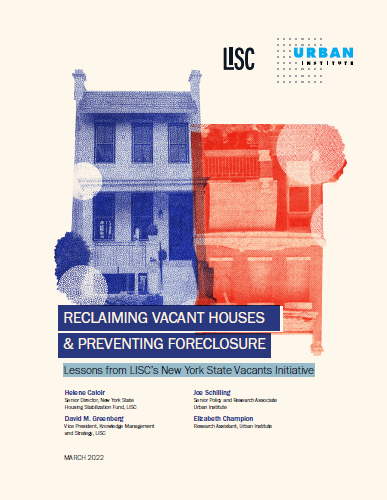Reclaiming Vacant Houses & Preventing Foreclosure
How can communities and local governments turn the tide on vacant and so-called “zombie” homes (those caught in foreclosure limbo) that drive crime, sap the resources of municipalities and undermine most significantly the wellbeing of Black and brown people and their neighborhoods? A report from LISC, in collaboration with Urban Institute, describes in concrete detail how a New York State law, proceeds from an Attorney General settlement with banks responsible for the foreclosure crisis, and a groundbreaking initiative stewarded by LISC have helped municipalities across New York State do just that. In just two or three years, the initiative has helped improve some 11,000 homes. And in the face of yet another crisis of housing instability, our report shows, it offers a flexible model for cities and towns across the country to get their arms around persistent vacant housing problems, and stave off new waves of foreclosure, keeping families in their homes, houses on the tax rolls, and maintaining stable communities.
Executive Summary
The housing instability caused by COVID has continued into 2022, even as foreclosure moratoria end at federal and state levels around the country. This report, Reclaiming Vacant Houses & Preventing Foreclosure: Lessons from LISC’s New York State Vacants Initiative, a collaboration of LISC and the Urban Institute, provides lessons and evidence of outcomes of a path-breaking law and LISC initiative in reducing vacant houses and preventing foreclosures in jurisdictions across New York State.
While all vacant houses can negatively impact communities, one particularly challenging type is the so-called “zombie.” Zombies are one- to four-unit houses with a mortgage in delinquency or somewhere in the foreclosure process. They commonly result from a bank initiating a foreclosure, but not seeing it through to completion. To respond to the policy challenge that Zombies present, the Abandoned Property Neighborhood Relief Act was passed by the New York State Legislature in 2016. The Act—also known as the “Zombie Law”— became a first-in-the-nation tool for cities, towns, and villages to begin addressing the backlog of vacant and distressed houses with bank liens. The law required financial institutions that held delinquent mortgages, or mortgages formally in the foreclosure process, to maintain and secure the houses and comply with exterior housing-code and property-maintenance requirements, with a penalty of $500 per day per house for failing to properly maintain the property.
While the law was necessary to address zombies, it was not in itself sufficient to carry out this work without funding and a parallel capacity-building and technical-assistance program (The Vacants Initiative) to help local governments enforce the law. From a broader pool of funds directed toward LISC through a settlement with several banks and the Office of the Attorney General, LISC committed $12.6 million to work with seventy-six cities, towns, and villages across the state. The program provided grants to municipalities, which used the funds to hire staff and consultants and to purchase technology. It also included technical-assistance and peer-learning components. Critical outcomes included:
- Within two to three years, the number of reported deteriorated vacants and/or Zombies among those grantees who had baseline estimates dropped from 25,752 to 14,600—an overall reduction of 11,152. Because this includes only 30 of 76 sites, this figure underestimates the total reduction that grantees experienced.
- By the end of the grant, grantees had enhanced capacity to coordinate and collaborate across local government departments or agencies, and with community-based organizations and nonprofit partners.
- LISC’s intermediary role was cited as a major part of the initiative’s successful implementation. Interviewees described LISC’s know-how as critical to building their capacity to more effectively implement the Zombie Law and address vacant houses more globally.
The experiences of the Zombie Law and Vacants Initiative offer a range of insights for state and local policymakers, government officials, as well as for the federal government and other states and communities. (In New York State, these lessons suggest enhancements to the Zombie Law to increase its transparency and bank accountability, and to address the challenge of heirs properties: houses where the owners have died and heirs have not come forward to probate a will or transfer title in a trust or establish the legal right to the house.)
- Program and practice recommendations. State and local government can support strategic code enforcement: proactive rather than reactive strategies that use data to analyze where to most equitably, efficiently, and effectively allocate resources and personnel. They can also support vacant property coordinators and task forces, and invest in intermediaries and regional networks to oversee capacity building.
- Recommendations to the Federal Government and Other States. A main lesson from the New York vacant house experience is that it is critical to have a state law that clarifies bank/lender responsibility to maintain vacant houses throughout the mortgage-foreclosure process. These should be accompanied by expanded resources to prevent and reclaim vacant houses and other abandoned properties, to help prevent mortgage and tax foreclosures, and to preserve existing housing. A key recommendation is to enable vacant house rehabilitation through proposed initiatives such as the Neighborhood Homes Investment Act.
